
Welcome to Hyperion Records, a British classical label devoted to presenting high-quality recordings of music of all styles and from all periods from the twelfth century to the twenty-first.
Hyperion offers both CDs, and downloads in a number of formats. The site is also available in several languages.
Please use the dropdown buttons to set your preferred options, or use the checkbox to accept the defaults.

Among settings of the Requiem Mass, Fauré’s is unique. It does not adhere to the time-honoured liturgical text, and as the composer saw death as a gentle release from earthly life, the horrors of the Day of Judgement are almost disregarded. The ‘Dies irae’, whose torments Verdi represented in the most vivid terms, is reduced to a brief interpolation in the ‘Libera me’ (‘Deliver me, O Lord, from eternal death’), and the work is serene and contemplative, the text purposely chosen to emphasize the word ‘requiem’.
Fauré had no particular reason for writing the Requiem, but while it was in the early stages of composition his mother died, and the first performance, which took place at the Madeleine on 16 January 1888, was a timely memorial. Only five movements were ready: ‘Introit and Kyrie’, ‘Sanctus’, ‘Pie Jesu’, ‘Agnus Dei’ and ‘In paradisum’. The forces required were modest: a mixed choir (with divided tenors and basses), a treble or soprano soloist, and an orchestra comprising lower strings (violas, cellos and double basses), harp, timpani and organ. There is a single violin to play a solo in the ‘Sanctus’, and the organ part is crucial and continuous.
In 1889 Fauré completed the ‘Offertoire’ (part of which he later re-used in the ninth of his piano Preludes, opus 103) and revived a ‘Libera me’ originally written twelve years earlier as an independent piece for baritone voice and organ. Horns, trumpets and trombones were added to the orchestra, the horns having a particularly important role in the ‘Libera me’ and an effective fanfare in the ‘Sanctus’. A baritone soloist was now needed for both the added sections, and this seven-movement version was presented, again at the Madeleine, on 21 January 1893.
It was not until 12 July 1900 that the third, and final, version of the Requiem was performed at the Trocadéro in Paris, with woodwind added to the orchestra and a full body of violins in the ‘Sanctus’, ‘Agnus Dei’, ‘Libera me’ and ‘In paradisum’. But the extent of Fauré’s involvement in this final version is unclear. The orchestra has become unwieldy and various liberties have been taken with the scoring, possibly by Fauré’s pupil Roger-Ducasse. It is hard to believe that a composer of such fastidious judgement as Fauré would have given it his approval. The 1893 version would seem the most convincing compromise.
The work has been described by Jean Chantavoine as ‘a paradisical imagining with no trace of torment or of doubt, scarcely even of mourning’. Temperamentally, Fauré could not tackle a detailed picture of Hell in a ‘Dies irae’, or portray a terrifying scene of anguish. His primary concern was the beauty of his music. The terrors of the afterlife are hardly more than touched upon, and the untroubled mood of the final ‘In paradisum’ differs from, say, a work like The Dream of Gerontius in the absence of any notion of Purgatory. The music of Fauré’s Requiem evokes comfort, dwelling on the fundamentally good nature present in everything.
from notes by Wadham Sutton © 1989
La messe de requiem de Fauré est unique: elle n’adhère pas au texte liturgique consacré par l’usage et comme la mort était, pour le compositeur, une paisible délivrance de la vie terrestre, les horreurs du Jour du jugement dernier y sont presque tenues pour quantité négligeable. Le «Dies irae», dont Verdi brossa les tourments dans les terms les plus frappants, se réduit à une brève interpolation dans le «Libera me» («Délivre-moi, Seigneur, de la mort éternelle»), d’où une œuvre sereine et contemplative, au texte choisi à dessein pour mettre en relief le mot «requiem».
Fauré n’avait aucune raison particulière d’écrire de Requiem mais, en tout début de rédaction, sa mère mourut et la première exécution, à la Madeleine, le 16 janvier 1888, fut un opportun mémorial. Seuls cinq mouvements étaient prêts («Introït et Kyrie», «Sanctus», «Pie Jesu», «Agnus Dei» et «In paradisum») et les forces requises étaient modestes: un chœur mixte (avec ténors et basses divisés), une voix solo de treble ou de soprano et un orchestre incluant des cordes graves (altos, violoncelles et contrebasses), une harpe, des timbales et un orgue. Il y a un solo de violon dans le «Sanctus» et la partie d’orgue, essentielle, est continue.
En 1889, Fauré acheva l’«Offertoire» (qu’il réutilisera en partie dans son Prélude pour piano no9 op. 103) et reprit un «Libera me» vieux de douze ans, un morceau indépendant originellement écrit pour baryton et orgue. Des cors, des trompettes et des trombones furent adjoints à l’orchestre—avec, pour les premiers, un rôle particulièrement important dans le «Libera me» et une impressionnante fanfare dans le «Sanctus». Cette version en sept mouvements, avec ajout d’un baryton pour les deux nouvelles sections, fut présentée, toujours à la Madeleine, le 21 janvier 1893.
Ce fut seulement le 12 juillet 1900 que le troisième et dernier état du Requiem fut joué au Trocadéro, avec des bois ajoutés à l’orchestre et un ensemble complet de violons dans le «Sanctus», l’«Agnus Dei», le «Libera me» et l’«In paradisum». On ignore, cependant, dans quelle mesure, au juste, Fauré s’impliqua dans cette mouture. L’orchestre est devenu lourd et on a pris des libertés avec l’instrumentation—on étant peut-être Roger-Ducasse, l’élève de Fauré. Difficile de croire qu’un compositeur aussi exigeant que Fauré eût approuvé cette version. Celle de 1893 nous apparaît comme le compromis le plus convaincant.
Pour Jean Chantavoine, cette œuvre est «une image paradisiaque, sans nulle trace de tourment ni de doute, ni même, presque, de deuil». Son caractère empêchait Fauré de s’atteler à une peinture détaillée de l’Enfer, dans un «Dies irae», ou de brosser une terrifiante scène d’angoisse. Seule le souciait la beauté de sa musique. Les terreurs de la vie après la mort sont tout juste effleurées et, en l’absence de toute notion de purgatoire, la quiétude de l’«In paradisum» final diffère d’une œuvre comme The Dream of Gerontius, par exemple. La musique du Requiem fauréen évoque le réconfort, appuyé sur la nature fondamentalement bonne qui est en toute chose.
extrait des notes rédigées par Wadham Sutton © 1989
Français: Hypérion
Unter den Vertonungen der Totenmesse ist Faurés Requiem einzigartig. Er hält sich nicht an den altehrwürdigen liturgischen Text, und da der Komponist den Tod als ein behutsames Sich-Loslösen vom irdischen Leben betrachtete, werden die Schrecken des Jüngsten Gerichts fast ignoriert. Das „Dies irae“, dessen Qualen Verdi in lebhaftester Weise darstellte, wird zu einer kurzen Einschiebung im „Libera me“ („Rette mich Herr, vor dem ewigen Tode“) reduziert und das Werk ist heiter und kontemplativ angelegt, wobei der Text absichtlich so gewählt ist, dass das Wort „Requiem“ betont wird.
Es gab für Fauré keinen bestimmten Anlass, das Requiem zu schreiben, doch starb zu Beginn des Entstehungsprozesses seine Mutter, so dass die erste Aufführung, die am 16. Januar 1888 in der Madeleine gegeben wurde, ein passendes Angedenken war. Nur fünf Sätze waren dafür fertiggestellt: das „Introitus und Kyrie“, „Sanctus“, „Pie Jesu“, „Agnus Dei“ und „In paradisum“. Die Besetzung des Werks war recht bescheiden: ein gemischter Chor (mit geteilten Tenören und Bässen), ein Solosopran (entweder eine Knaben- oder eine weibliche Sopranstimme) und ein Orchester, das aus tiefen Streichern (Bratschen, Violoncelli und Kontrabässe), Harfe, Pauke und Orgel bestand. Zudem hat eine einzelne Violine ein Solo im „Sanctus“; die Orgelstimme ist besonders wichtig und durchgehend eingesetzt.
1889 stellte Fauré das „Offertoire“ fertig (das er später teilweise in dem neunten seiner Préludes für Klavier, op. 103, wiederverwendete) und griff ein „Libera me“ auf, das er ursprünglich zwölf Jahre zuvor als ein eigenständiges Stück für Baritonstimme und Orgel komponiert hatte. Dem Orchester wurden Hörner, Trompeten und Posaunen hinzugefügt, wobei die Hörner im „Libera me“ eine besonders wichtige Rolle spielen und im „Sanctus“ eine wirkungsvolle Fanfare haben. Für die beiden neuen Teile wurde nun auch ein Solobariton benötigt und diese siebensätzige Version wurde, wiederum in der Madeleine, am 21. Januar 1893 uraufgeführt.
Die dritte und letzte Version des Requiems wurde erst am 12. Juli 1900 im Trocadéro in Paris aufgeführt, wobei dem Orchester Holzbläser und ein vollständiger Geigenapparat im „Sanctus“, „Agnus Dei“, „Libera me“ und „In paradisum“ hinzugefügt worden waren. Es ist jedoch unklar, inwieweit Fauré diese endgültige Version selbst komponiert hatte. Das Orchester ist etwas schwerfällig geworden und in der Besetzung hat sich jemand, möglicherweise der Fauré-Schüler Roger-Ducasse, mehrere Freiheiten erlaubt. Es scheint nicht plausibel, dass ein penibler Komponist wie Fauré dem seine Zustimmung gegeben hätte. Die Version von 1893 scheint demnach der überzeugendste Kompromiss zu sein.
Das Werk ist von Jean Chantavoine als „eine paradiesische Vorstellung ohne jede Spur der Qual, des Zweifels und sogar kaum der Trauer“ beschrieben worden. Fauré war aufgrund seines Temperaments nicht in der Lage, ein genaues Bild der Hölle in einem „Dies irae“ zu entwerfen, oder eine furchteinflößende Szene des Schmerzes darzustellen. Sein Hauptanliegen war die Schönheit seiner Musik. Die Schrecken des Lebens nach dem Tod werden kaum erwähnt und die ungetrübte Stimmung des letzten Satzes „In paradisum“ unterscheidet sich von einem Werk wie etwa The Dream of Gerontius durch die Abwesenheit jeglicher Andeutungen auf das Fegefeuer. Die Musik von Faurés Requiem stellt Behaglichkeit dar und verweilt bei der grundsätzlich gutartigen Natur, die in allen Dingen vorhanden ist.
aus dem Begleittext von Wadham Sutton © 1989
Deutsch: Viola Scheffel
 Fauré: Requiem & other choral works Fauré: Requiem & other choral worksThis critically acclaimed album was recorded in January 2014 with the Orchestra of the Age of Enlightenment and former choral scholar Gerald Finley. It faithfully recreates the 1889 premiere of the Requiem, the instruments and techniques used by t ...» More |
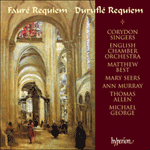 Fauré & Duruflé: Requiem Fauré & Duruflé: Requiem‘Superb’ (Fanfare, USA)» More |
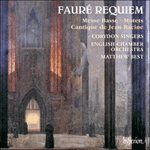 Fauré: Requiem & other sacred music Fauré: Requiem & other sacred musicA perennial best-seller in the Hyperion catalogue, this noble recording of the Fauré Requiem is here coupled with the Messe Basse and Cantique de Jean Racine.» More |
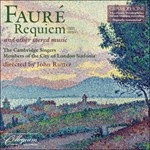 Fauré: Requiem & other sacred music Fauré: Requiem & other sacred musicFamously re-discovered by Rutter in the Bibliothèque Nationale in Paris after a century of neglect, the intimate original version of Fauré’s Requiem is performed here by the Cambridge Singers and members of the City of London Sinfonia.» More |
 Remembrance Remembrance‘A lasting souvenir of a moving occasion, a fitting tribute to a great man, but above all, fine listening’ (Gramophone)» More |
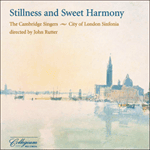 Stillness and Sweet Harmony Stillness and Sweet HarmonyThis is music to bring peace. From the wealth of music spanning over ten centuries recorded by the Cambridge Singers, John Rutter has selected fifteen serene and tranquil tracks from Collegium albums.» More |
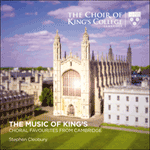 The music of King's The music of King'sThis new recording presents nineteen opulently recorded treasures from the immense repertoire of this most august of choirs, everything from Baroque and Renaissance masterpieces to fresh arrangements of American and Chinese folk songs.» More |

